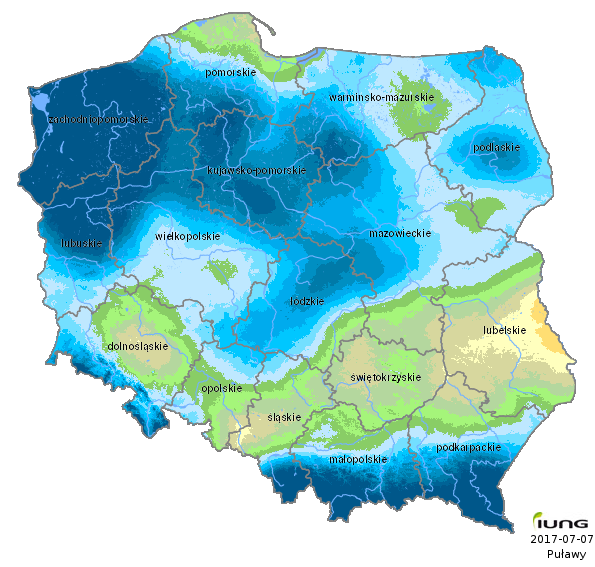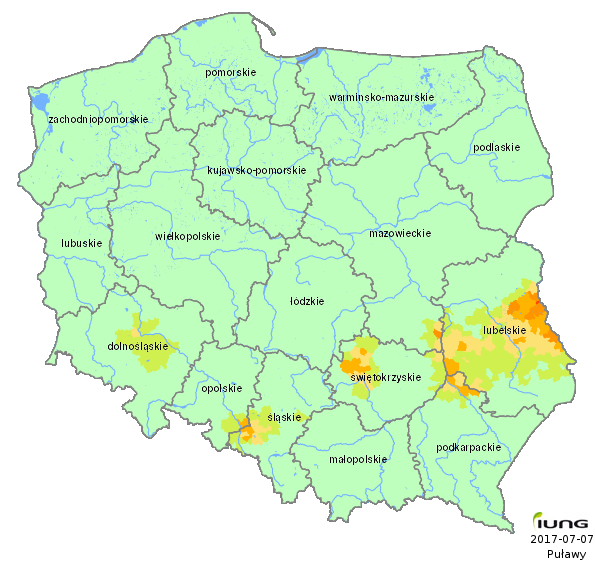ARCHIVES (2017)
Do roku 2016 raport oznaczony numerem 1 był tworzony za okres od 1 kwietnia do 31 maja. Od roku 2017 analizy są wykonywane o dekadę wcześniej czyli 1 raport oznacza okres od 21 marca do 20 maja
Communication report regarding the incidences of drought conditions in Poland
Year: 2017; period: 05 (1.V - 30.VI)
The Institute of Soil Science and Plant Cultivation – State Research Institute, in accordance with an Act of the Minister of Agriculture and Rural Development has developed the climatic water balance for all 2478 Polish local districts and, on the basis of soil categories, calculated the current risk of agricultural drought for the following crops: winter and spring cereals, grain maize and maize for silage, rape and turnip rape, potatoes, sugar beet, hops, tobacco, ground vegetables, fruit shrubs and trees, strawberries and legumes.
In the fifth reporting period, i.e. from May 1st t° June 30th 2017, IUNG-PIB stated agricultural drought conditions in Poland. The Climatic Water Balance values, which are the basis for assessing the risk of agricultural drought, are negative for the majority of areas.
In the current sixty-day reporting period drought occurs in:
- spring cereals
- winter cereals
- legumes
Currently the risk of agricultural drought occurs in spring cereals cultivated on soils of Category I and II.
Category I consists of very light soils, granulometric groups as follows:
Loose sand
Loose dusty sand
Slightly loamy sand
Slightly loamy dusty sand
Category II consists of light soils, granulometric groups as follows:
Light loamy sand
Light loamy dusty sand
Heavy loamy sand
Heavy loamy dusty sand
Drought occurs in spring cereals in 7 voivodships in 207 local districts (gminas) in Poland (i.e. 8.35% of all local districts in Poland) in the area of 0.87% of arable land. Table 1 presents detailed data on drought occurrence for local districts and the area of arable land in particular voivodships.
Table 1.
| No. | Voivodship | Number of local districts | Number of local districts at risk | Share of local districts at risk [%] | Share of the area at risk [%] |
|---|---|---|---|---|---|
| 1 | lubelskie | 213 | 110 | 51.64 | 6.65 |
| 2 | świętokrzyskie | 102 | 27 | 26.47 | 3.22 |
| 3 | śląskie | 167 | 26 | 15.57 | 1.00 |
| 4 | dolnośląskie | 169 | 22 | 13.02 | 0.45 |
| 5 | podkarpackie | 160 | 10 | 6.25 | 0.81 |
| 6 | mazowieckie | 314 | 6 | 1.91 | 0.27 |
| 7 | opolskie | 71 | 6 | 8.45 | 0.15 |
Drought was also noted in winter cereals. It occurs in crops located in lubelskie voivodship on soils of Category I. Drought in winter cereals occurs in 0.81% of all local districts, 0.13% of arable land in Poland. Table 1 presents detailed data on drought occurrence for local districts and the area of arable land in lubelskie voivodship.
Table 2.
| No. | Voivodship | Number of local districts | Number of local districts at risk | Share of local districts at risk [%] | Share of the area at risk [%] |
|---|---|---|---|---|---|
| 1. | lubelskie | 213 | 20 | 9.39 | 1.42 |
Drought occurred also in legumes in lubelskie voivodship on soils of Category I. Drought occurs in 0.48% of all local districts in Poland, in 0.06% of arable land. Table 3 presents detailed data on drought occurrence for local districts and the area of arable land in lubelskie voivodship.
Table 3.
| No. | Voivodship | Number of local districts | Number of local districts at risk | Share of local districts at risk [%] | Share of the area at risk [%] |
|---|---|---|---|---|---|
| 1. | lubelskie | 213 | 12 | 5.63 | 0.68 |
The average value of Climatic Water Balance in Poland in the current sixty-day reporting period was -91 mm, which only slightly increased in comparison to the previous reporting period (by 2 mm). However, it should be noted that the CWB values changed significantly in many regions due to weather conditions. In some regions the CWB values increased by 90 mm and in others decreased by 80 mm. In the whole country they were higher than -179 mm and exceeded the critical values for three crops, causing agricultural drought conditions in 8.35% of local districts in Poland. The lowest CWB values, from -170 to -179 were recorded in Łęczyńsko-Włodawska Plain and in Dubienka Depression.
Low CWB values were also recorded in the area of the Horodło Plateau (Grzęda Horodelska), the Chełm Hills (Pagóry chełmskie), and Działy Grabowieckie, from -160 to -169 mm. Considerable water deficiency, from -120 to -159 mm was noted in the Uplands: Lubelska, Małopolska, Krakowsko-Częstochowska, Silesian Upland and Silesian Lowland.
Low water deficiency occurred also in the Pomeranian Lake District, in the northern regions of the Masovian Lowland and in Carpathian Foothills.
May was warm this year, with air temperature ranging from 10 to 15ºC. The highest temperatures were recorded in the Silesian and Central Masovian Lowlands and in the Sandomierska Basin (14-15ºC), where they exceeded the multiannual norm by 0.5-1ºC. The lowest temperatures ranging from 11 to 13ºC occurred in the north of the country. In the vast majority of the country temperature ranged from 13 to 14ºC and was close to the multiannual norm
All three decades of June were characterised by highly diversified temperatures, and the air temperature distribution was similar in the whole country. The lowest temperatures were recorded in the north-eastern part of the country, from even below 14 to 15ºC in the first decade, 1ºC higher in the second and 2ºC higher in the third decade of June. In the western, south-western and eastern parts of the country were recorded the highest temperatures, between 16 and 18ºC, and exceeding 20ºC in the third decade of June.
In May precipitation was also highly diversified. Precipitation from below 20 to 30 mm occurred in the Silesian Lowland and in the northern and north-eastern regions of the country, constituting 30-70% of the multiannual norm. In the vast majority of areas precipitation ranged from 30 to 50 mm, which is 70-90% of the norm. Very high precipitation (60-110 mm) was recorded in the Szczecińska and Podlaska Lowlands and in the Carpathian Foothills, where it constituted 100 to 170% of the multiannual norm. Particularly intense precipitation occurred in Podhale and Tatra Mountains, 110 to more than 130 mm, which constituted 100 to 110% of the multiannual norm.
The first decade of July was also highly diversified in terms of precipitation distribution. In the eastern part of the country it ranged from below 5 to 10 mm. More intense precipitation occurred in the western and central parts of Poland, ranging from 10 to 50, or even more than 60 mm. In the second decade, on the other hand, in the eastern and northern regions precipitation was relatively intense, from 10 to more than 60 mm. In the rest of the country it ranged from 5 to 20 mm. In the third decade of June precipitation was characterized by the highest degree of diversification. In the south, precipitation was very low, between 5 and 10 mm, while in the vast majority of Central Poland it was quite intense, between 40 and 90 mm.
In the current sixty-day reporting period we can observe a high diversification of Climatic Water Balance values around the country, which causes water deficiency in some regions, whilst in the others water conditions for crops are good or very good, e.g. in the Pomeranian Lake District. The areas particularly at risk of water deficiency are: Lubelskie, western part of Lesser Poland and Lower Silesia.
Report prepared by:
Dr hab. Andrzej Doroszewski, prof. nadzw.
Dr hab. Rafał Pudełko
Dr Katarzyna Żyłowska
Mgr Piotr Koza
Mgr Elżbieta Wróblewska
Reports
- Report 14 (1.VIII - 30.IX)
- Report 13 (21.VII - 20.IX)
- Report 12 (11.VII - 10.IX)
- Report 11 (1.VII - 31.VIII) +
- Report 10 (21.VI - 20.VIII)
- Report 09 (11.VI - 10.VIII)
- Report 08 (1.VI - 31.VII)
- Report 07 (21.V - 20.VII)
- Report 06 (11.V - 10.VII) +
- Report 05 (1.V - 30.VI) +
- Report 04 (21.IV - 20.VI)
- Report 03 (11.IV - 10.VI)
- Report 02 (1.IV - 31.V)
- Report 01 (21.III - 20.V)





